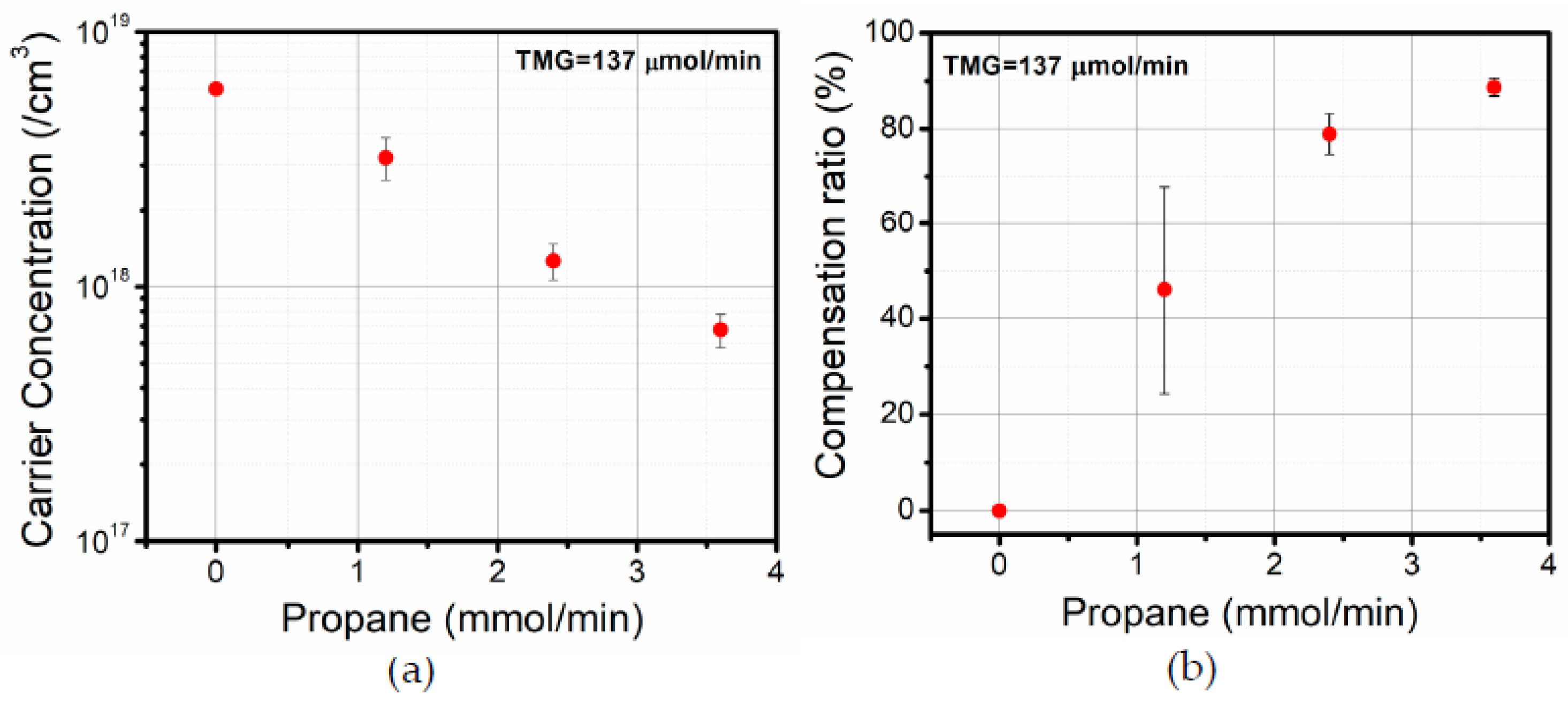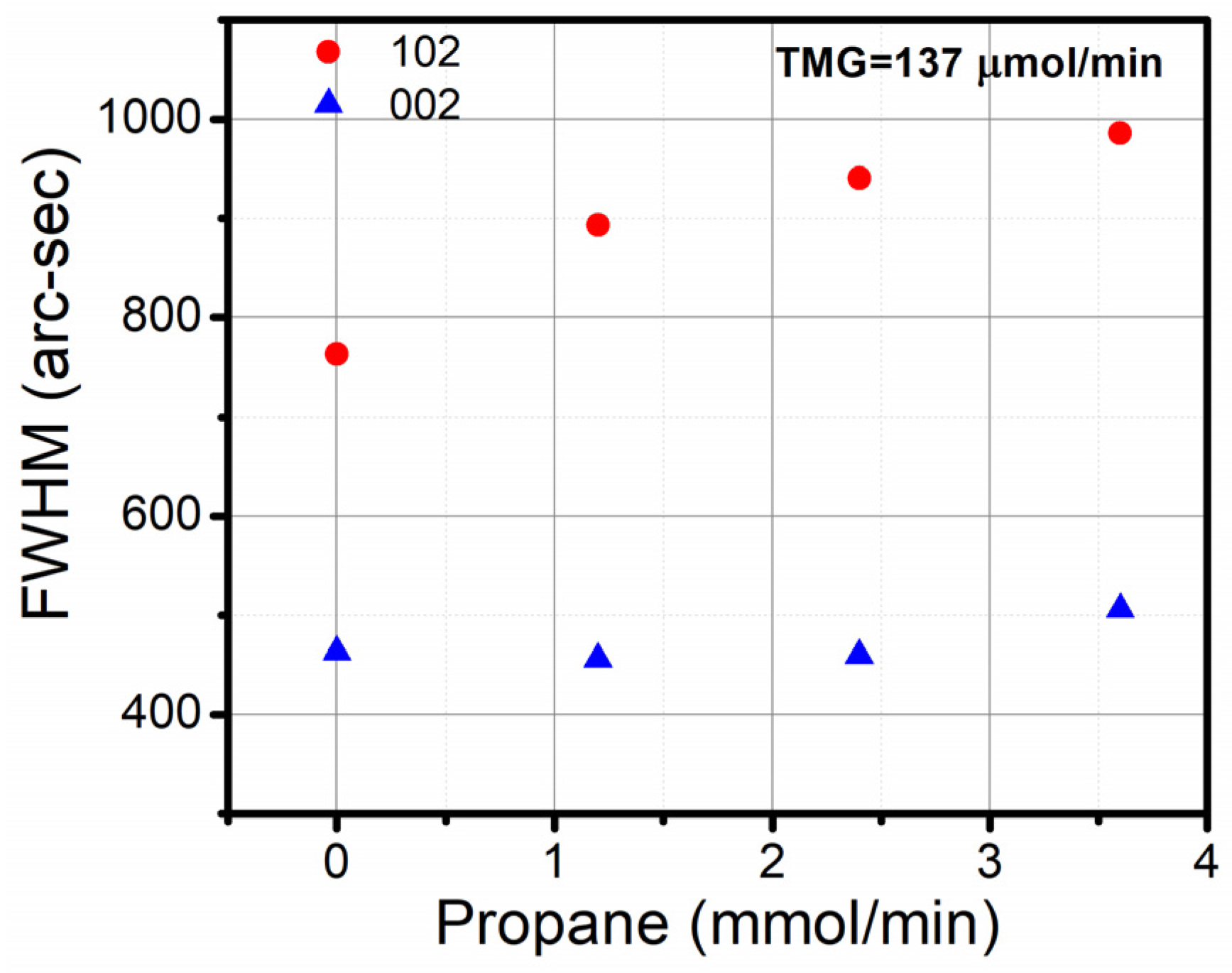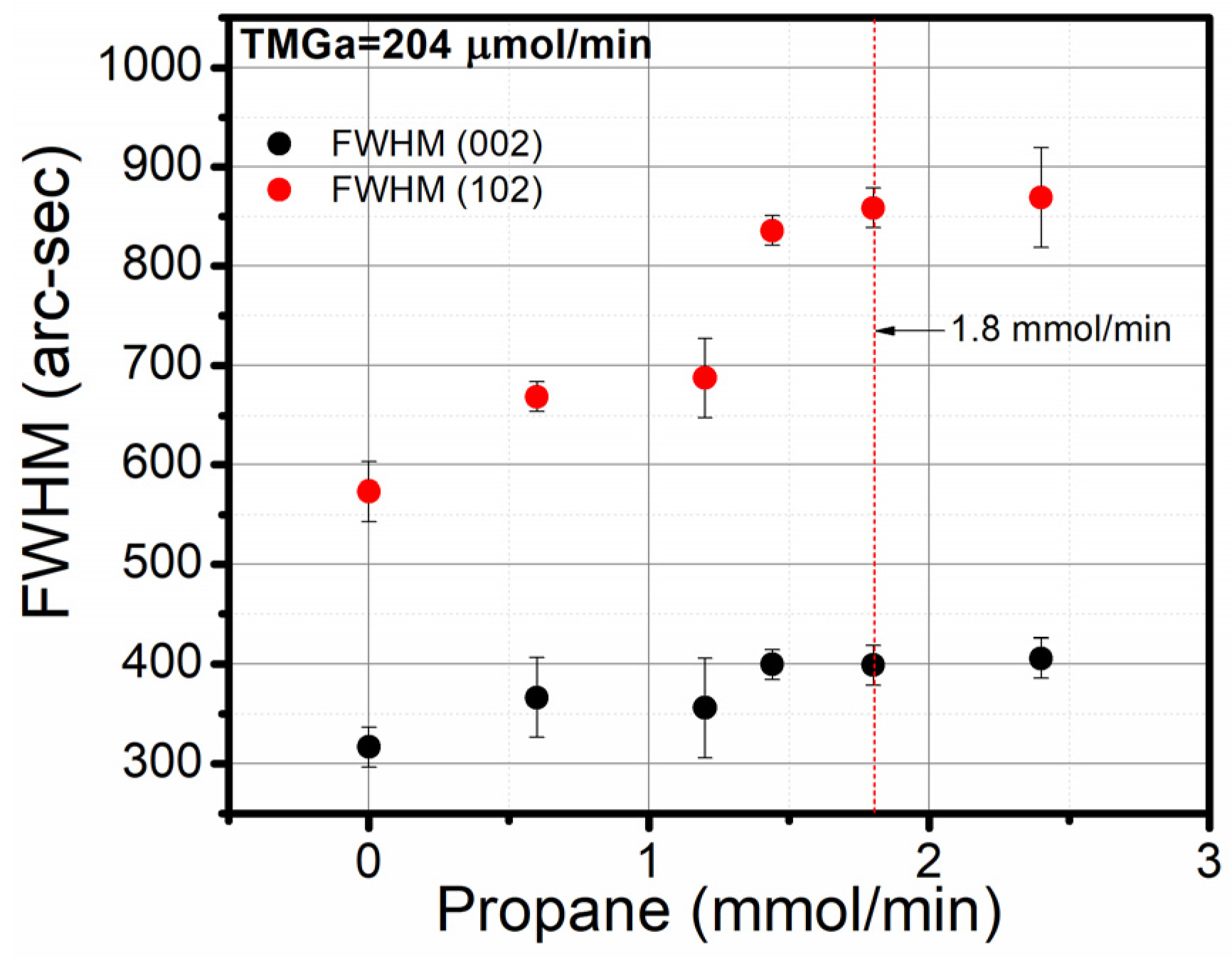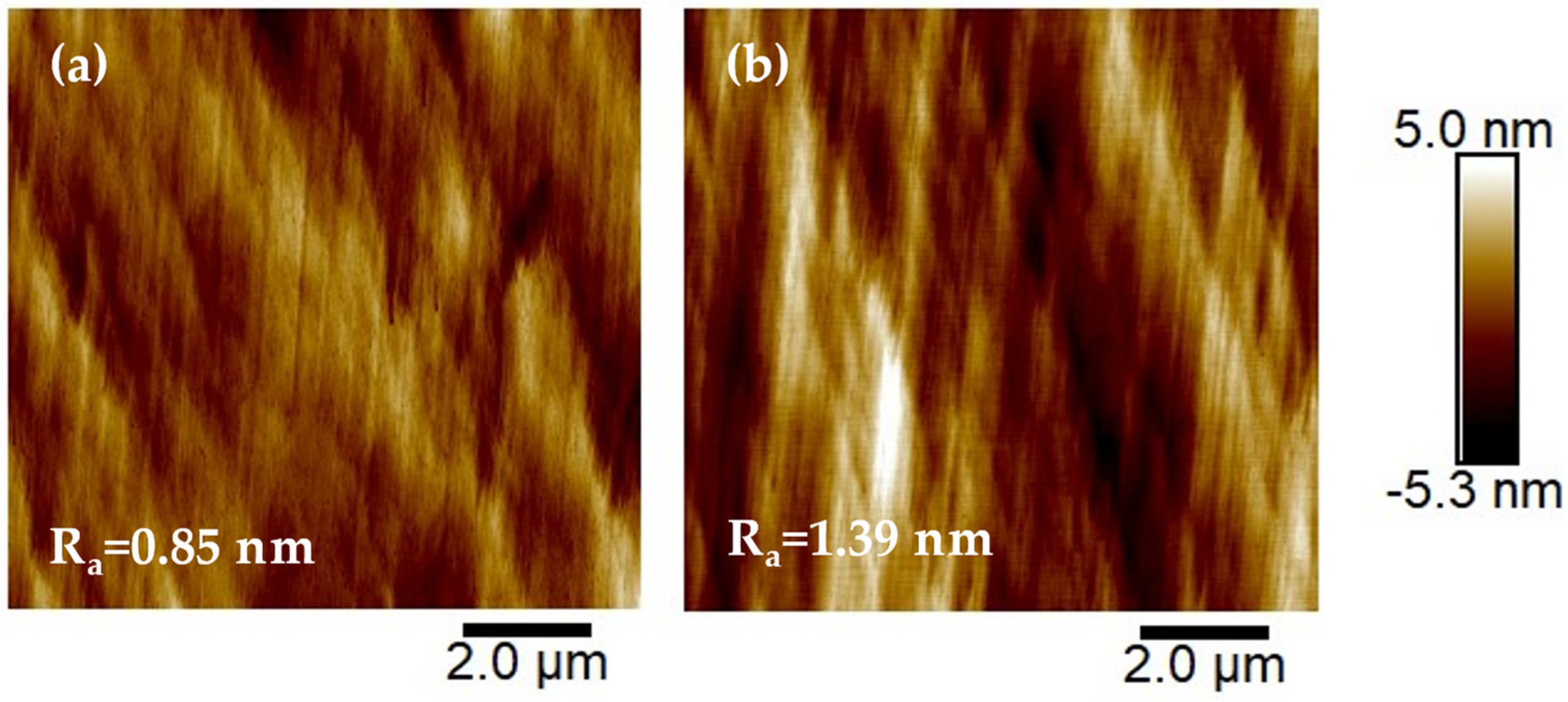First Demonstration of Extrinsic C-Doped Semi-Insulating N-Polar GaN Using Propane Precursor Grown on Miscut Sapphire Substrate by MOCVD
Abstract
:1. Introduction
2. Experimental Methods
3. Results and Discussion
4. Conclusions
Author Contributions
Funding
Data Availability Statement
Conflicts of Interest
References
- Romanczyk, B.; Li, W.; Guidry, M.; Hatui, N.; Krishna, A.; Wurm, C.; Keller, S.; Mishra, U.K. N-Polar GaN-on-Sapphire Deep Recess HEMTs With High W-Band Power Density. IEEE Electron Device Lett. 2020, 41, 1633–1636. [Google Scholar] [CrossRef]
- Romanczyk, B.; Wienecke, S.; Guidry, M.; Li, H.; Ahmadi, E.; Zheng, X.; Keller, S.; Mishra, U.K. Demonstration of Constant 8 W/mm Power Density at 10, 30, and 94 GHz in State-of-the-Art Millimeter-Wave N-Polar GaN MISHEMTs. IEEE Trans. Electron Devices 2017, 65, 45–50. [Google Scholar] [CrossRef]
- Li, W.; Romanczyk, B.; Guidry, M.; Akso, E.; Hatui, N.; Wurm, C.; Liu, W.; Shrestha, P.; Collins, H.; Clymore, C.; et al. Record RF Power Performance at 94 GHz From Millimeter-Wave N-Polar GaN-on-Sapphire Deep-Recess HEMTs. IEEE Trans. Electron Devices 2023, 70, 2075–2080. [Google Scholar] [CrossRef]
- Chung, B.-C.; Gershenzon, M. The influence of oxygen on the electrical and optical properties of GaN crystals grown by metalorganic vapor phase epitaxy. J. Appl. Phys. 1992, 72, 651–659. [Google Scholar] [CrossRef]
- Fichtenbaum, N.; Mates, T.; Keller, S.; DenBaars, S.; Mishra, U. Impurity incorporation in heteroepitaxial N-face and Ga-face GaN films grown by metalorganic chemical vapor deposition. J. Cryst. Growth 2008, 310, 1124–1131. [Google Scholar] [CrossRef]
- Tanikawa, T.; Kuboya, S.; Matsuoka, T. Control of impurity concentration in N-polar (0001¯) GaN grown by metalorganic vapor phase epitaxy. Phys. Status Solidi (b) 2017, 254, 1600751. [Google Scholar] [CrossRef]
- Tavernier, P.; Margalith, T.; Williams, J.; Green, D.; Keller, S.; DenBaars, S.; Mishra, U.; Nakamura, S.; Clarke, D. The growth of N-face GaN by MOCVD: Effect of Mg, Si, and In. J. Cryst. Growth 2004, 264, 150–158. [Google Scholar] [CrossRef]
- Sumiya, M.; Yoshimura, K.; Ohtsuka, K.; Fuke, S. Dependence of impurity incorporation on the polar direction of GaN film growth. Appl. Phys. Lett. 2000, 76, 2098–2100. [Google Scholar] [CrossRef]
- Szymanski, D.; Wang, K.; Kaess, F.; Kirste, R.; Mita, S.; Reddy, P.; Sitar, Z.; Collazo, R. Systematic oxygen impurity reduction in smooth N-polar GaN by chemical potential control. Semicond. Sci. Technol. 2022, 37, 015005. [Google Scholar] [CrossRef]
- Li, X.; Bergsten, J.; Nilsson, D.; Danielsson, Ö.; Pedersen, H.; Rorsman, N.; Janzén, E.; Forsberg, U. Carbon doped GaN buffer layer using propane for high electron mobility transistor applications: Growth and device results. Appl. Phys. Lett. 2015, 107, 262105. [Google Scholar] [CrossRef]
- Amilusik, M.; Zajac, M.; Sochacki, T.; Lucznik, B.; Fijalkowski, M.; Iwinska, M.; Wlodarczyk, D.; Somakumar, A.K.; Suchocki, A.; Bockowski, M. Carbon and Manganese in Semi-Insulating Bulk GaN Crystals. Materials 2022, 15, 2379. [Google Scholar] [CrossRef]
- Yamamoto, T.; Sazawa, H.; Nishikawa, N.; Kiuchi, M.; Ide, T.; Shimizu, M.; Inoue, T.; Hata, M. Reduction in Buffer Leakage Current with Mn-Doped GaN Buffer Layer Grown by Metal Organic Chemical Vapor Deposition. Jpn. J. Appl. Phys. 2013, 52, 08JN12. [Google Scholar] [CrossRef]
- Reshchikov, M.A.; Ghimire, P.; Demchenko, D.O. Magnesium acceptor in gallium nitride. I. Photoluminescence from Mg-doped GaN. Phys. Rev. B 2018, 97, 205204. [Google Scholar] [CrossRef]
- Hautakangas, S.; Oila, J.; Alatalo, M.; Saarinen, K.; Liszkay, L.; Seghier, D.; Gislason, H.P. Vacancy Defects as Compensating Centers in Mg-Doped GaN. Phys. Rev. Lett. 2003, 90, 137402. [Google Scholar] [CrossRef]
- Nakamura, S.; Iwasa, N.; Senoh, M.S.M.; Mukai, T.M.T. Hole Compensation Mechanism of P-Type GaN Films. Jpn. J. Appl. Phys. 1992, 31, 1258. [Google Scholar] [CrossRef]
- Ronning, C.; Carlson, E.P.; Thomson, D.B.; Davis, R.F. Optical activation of Be implanted into GaN. Appl. Phys. Lett. 1998, 73, 1622–1624. [Google Scholar] [CrossRef]
- Kucheyev, S.; Williams, J.; Pearton, S. Ion implantation into GaN. Mater. Sci. Eng. R Rep. 2001, 33, 51–108. [Google Scholar] [CrossRef]
- Majid, A.; Ali, A.; Zhu, J.; Wang, Y.; Yang, H. An evidence of defect gettering in GaN. Phys. B Condens. Matter 2008, 403, 2495–2499. [Google Scholar] [CrossRef]
- Heikman, S.; Keller, S.; DenBaars, S.P.; Mishra, U.K. Growth of Fe doped semi-insulating GaN by metalorganic chemical vapor deposition. Appl. Phys. Lett. 2002, 81, 439–441. [Google Scholar] [CrossRef]
- Xing, H.; Green, D.S.; Yu, H.; Mates, T.; Kozodoy, P.; Keller, S.; DenBaars, S.P.; Mishra, U.K. Memory Effect and Redistribution of Mg into Sequentially Regrown GaN Layer by Metalorganic Chemical Vapor Deposition. Jpn. J. Appl. Phys. 2003, 42, 50–53. [Google Scholar] [CrossRef]
- Heikman, S.; Keller, S.; Mates, T.; DenBaars, S.; Mishra, U. Growth and characteristics of Fe-doped GaN. J. Cryst. Growth 2003, 248, 513–517. [Google Scholar] [CrossRef]
- Heikman, S.J. MOCVD Growth Technologies for Applications in AlGaN/GaN High Electron Mobility Transistors. Ph.D. Thesis, University of California, Santa Barbara, CA, USA, September 2002. [Google Scholar]
- Keller, S.; Li, H.; Laurent, M.; Hu, Y.; Pfaff, N.; Lu, J.; Brown, D.F.; A Fichtenbaum, N.; Speck, J.S.; DenBaars, S.P.; et al. Recent progress in metal-organic chemical vapor deposition of (0001) N-Polar Group-III Nitrides. Semicond. Sci. Technol. 2014, 29, 113001. [Google Scholar] [CrossRef]
- Li, X.; Danielsson, Ö.; Pedersen, H.; Janzén, E.; Forsberg, U. Precursors for carbon doping of GaN in chemical vapor deposition. J. Vac. Sci. Technol. B 2015, 33, 021208. [Google Scholar] [CrossRef]
- Lundin, W.; Sakharov, A.; Zavarin, E.; Kazantsev, D.; Ber, B.; Yagovkina, M.; Brunkov, P.; Tsatsulnikov, A. Study of GaN doping with carbon from propane in a wide range of MOVPE conditions. J. Cryst. Growth 2016, 449, 108–113. [Google Scholar] [CrossRef]
- Wu, S.; Yang, X.; Zhang, Q.; Shang, Q.; Huang, H.; Shen, J.; He, X.; Xu, F.; Wang, X.; Ge, W.; et al. Direct evidence of hydrogen interaction with carbon: C–H complex in semi-insulating GaN. Appl. Phys. Lett. 2020, 116, 262101. [Google Scholar] [CrossRef]
- Wu, S.; Yang, X.; Wang, Z.; Ouyang, Z.; Huang, H.; Zhang, Q.; Shang, Q.; Shen, Z.; Xu, F.; Wang, X.; et al. Influence of intrinsic or extrinsic doping on charge state of carbon and its interaction with hydrogen in GaN. Appl. Phys. Lett. 2022, 120. [Google Scholar] [CrossRef]
- Fichtenbaum, N.A. Growth of Nitrogen-Face Gallium Nitride by MOCVD; Order No. 3330425; University of California: Santa Barbara, CA, USA, 2008. [Google Scholar]
- Bisi, D.; Romanczyk, B.; Liu, X.; Gupta, G.; Brown-Heft, T.; Birkhahn, R.; Lal, R.; Neufeld, C.J.; Keller, S.; Parikh, P.; et al. Commercially Available N-polar GaN HEMT Epitaxy for RF Applications. In Proceedings of the 2021 IEEE 8th Workshop on Wide Bandgap Power Devices and Applications (WiPDA), Redondo Beach, CA, USA, 7–11 November 2021; pp. 250–254. [Google Scholar] [CrossRef]
- Lesnik, A.; Hoffmann, M.P.; Fariza, A.; Bläsing, J.; Witte, H.; Veit, P.; Hörich, F.; Berger, C.; Hennig, J.; Dadgar, A.; et al. Properties of C-doped GaN. Phys. Status Solidi (b) 2016, 254, 1600708. [Google Scholar] [CrossRef]
- Seifert, W.; Franzheld, R.; Butter, E.; Sobotta, H.; Riede, V. On the origin of free carriers in high-conducting n-GaN. Cryst. Res. Technol. 1983, 18, 383–390. [Google Scholar] [CrossRef]
- Sumner, J.; Das Bakshi, S.; Oliver, R.A.; Kappers, M.J.; Humphreys, C.J. Unintentional doping in GaN assessed by scanning capacitance microscopy. Phys. Status Solidi (b) 2008, 245, 896–898. [Google Scholar] [CrossRef]







| Deposition Condition | TMGa Flow Rate (μmol/Min) | Propane Flow Rate (mmol/Min) |
|---|---|---|
| G1 | 137 | 0 |
| 1.2 | ||
| 2.4 | ||
| 3.6 | ||
| G2 | 204 | 0 |
| 0.6 | ||
| 1.2 | ||
| 1.4 | ||
| 1.8 | ||
| 2.4 |
Disclaimer/Publisher’s Note: The statements, opinions and data contained in all publications are solely those of the individual author(s) and contributor(s) and not of MDPI and/or the editor(s). MDPI and/or the editor(s) disclaim responsibility for any injury to people or property resulting from any ideas, methods, instructions or products referred to in the content. |
© 2023 by the authors. Licensee MDPI, Basel, Switzerland. This article is an open access article distributed under the terms and conditions of the Creative Commons Attribution (CC BY) license (https://creativecommons.org/licenses/by/4.0/).
Share and Cite
Mukhopadhyay, S.; Sanyal, S.; Wang, G.; Gupta, C.; Pasayat, S.S. First Demonstration of Extrinsic C-Doped Semi-Insulating N-Polar GaN Using Propane Precursor Grown on Miscut Sapphire Substrate by MOCVD. Crystals 2023, 13, 1457. https://doi.org/10.3390/cryst13101457
Mukhopadhyay S, Sanyal S, Wang G, Gupta C, Pasayat SS. First Demonstration of Extrinsic C-Doped Semi-Insulating N-Polar GaN Using Propane Precursor Grown on Miscut Sapphire Substrate by MOCVD. Crystals. 2023; 13(10):1457. https://doi.org/10.3390/cryst13101457
Chicago/Turabian StyleMukhopadhyay, Swarnav, Surjava Sanyal, Guangying Wang, Chirag Gupta, and Shubhra S. Pasayat. 2023. "First Demonstration of Extrinsic C-Doped Semi-Insulating N-Polar GaN Using Propane Precursor Grown on Miscut Sapphire Substrate by MOCVD" Crystals 13, no. 10: 1457. https://doi.org/10.3390/cryst13101457
APA StyleMukhopadhyay, S., Sanyal, S., Wang, G., Gupta, C., & Pasayat, S. S. (2023). First Demonstration of Extrinsic C-Doped Semi-Insulating N-Polar GaN Using Propane Precursor Grown on Miscut Sapphire Substrate by MOCVD. Crystals, 13(10), 1457. https://doi.org/10.3390/cryst13101457








